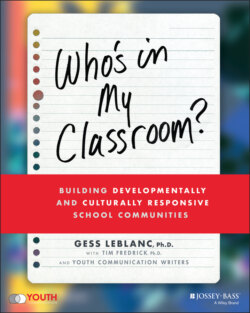Читать книгу Who's In My Classroom? - Tim Fredrick - Страница 6
Other Things to Know about This Book
ОглавлениеStudent Stories: All student examples in the book are from stories written by teens in the Youth Communication writing program. We describe a bit more about that work in Chapters 1 and 8. We give the age of the student at the time he or she wrote the story. All of these stories originally appeared in Youth Communication's print and digital magazines. As you will see, some of the students choose to be anonymous and others chose to have their names on their stories.
Language: Who are I, We, and You? When you see I in the text, it mostly refers to me (Gess LeBlanc) and my experiences. At times, it also references the experience of Tim Fredrick and other Youth Communication staff. Tim and I are both teachers who have experienced many of the challenges that all teachers face, so we often switch to we when writing about common issues that we all face in teaching.
You, of course, are the reader. The primary audience for this book is educators, including teachers and out-of-school staff, students who are studying to be teachers, and school and district administrators. Regardless of your race, gender, sexual orientation, religion, or other demographic or cultural descriptor that is important to you, if you are a teacher in today's increasingly diverse America, you are going to have students whose backgrounds are very different from your own. Thus, this book is for all educators.
Pronouns: In recent years, in our work with students and colleagues, we have learned not to presume someone's preferred pronoun or that a person fits into the male/female gender binary. Though it is stylistically inconsistent, in this book, we go back and forth between he, she, and they.
Resources: We refer to many resources that you can use to implement ideas in the book in your own classrooms, your school, and your district. If you are reading an electronic version of this book, you can just follow the link. Otherwise, we've given enough information to search for the resource. You will note that our references to the resources are suggestive; we don't describe the resources in detail. We encourage you to access the ones that fit the needs of your school and community.
However, we do offer professional development, which can include exploring and practicing many of the ideas in the “What Teachers Can Do” and “What Schools and Districts Can Do” sections of this book. (See the following chart for contact information for Gess LeBlanc and Youth Communication.)
Academic Research: We also refer to many academic studies and briefly summarize the key points that are relevant to DCRT. You are, of course, welcome to follow the footnotes to learn more about the findings and the nuances of the studies.
We hope this book will spur you to think about your teaching and to make changes in your classes, your school, and your district. We know that identifying practices that improve classroom teaching and district policies so students are more likely to achieve the best possible outcomes is a never-ending process. Our teaching and professional development work is part of that process, and we are always eager to improve it. We invite suggestions about the ideas in this book and welcome opportunities to work with school districts.
| Gess LeBlanc | Tim Fredrick |
| Hunter College | Youth Communication |
| School of Education | training@youthcomm.org |
| gleblanc@hunter.cuny.edu |
